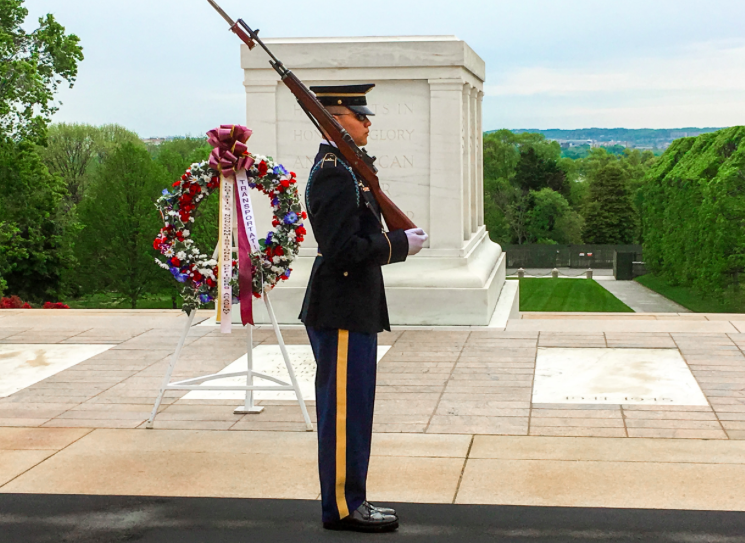


Through the ages, one of the consequences of warfare has been large numbers of unidentified dead. Sometimes unidentified remains resulted from poor record keeping, the damage that weapons of war inflicted on bodies, or the haste required to bury the dead and mark gravesites. In the United States prior to the Civil War, unidentified remains were often buried in mass graves. At Arlington National Cemetery, these include unknown soldiers and sailors from the War of 1812 who were discovered buried at the Washington Barracks and reburied at Arlington National Cemetery in 1905.
During the Civil War (1861-1865), high casualty rates and lack of personal identification led to large numbers of unknowns originally buried along marching routes or battlefields. The system of national cemeteries was established in 1862 to ensure the proper burial of all service members. Still, many unknown remains were recovered in the years following the Civil War. At Arlington National Cemetery, there are individual Civil War unknown burials as well as the remains of 2,111 Union and Confederate soldiers buried beneath the Tomb of the Civil War Unknowns. While exact numbers are unknown, estimates indicate that nearly half of the Civil War dead were never identified.
During World War I, U S service members received aluminum identification discs, the precursors to “dog tags,” to aid the process of identifying remains. The War Department created a new unit in the Quartermaster Corps, the Graves Registration Service, to oversee burials. During and after World War I, however, Americans debated whether bodies should be repatriated. With more than 100,000 American casualties (compared to fewer than 3,000 in the Spanish-American War), repatriation was more challenging.
In December 1920, New York Congressman and World War I veteran Hamilton Fish Jr. proposed legislation that provided for the interment of one unknown American soldier at a special tomb to be built in Arlington National Cemetery. The purpose of the legislation was “to bring home the body of an unknown American warrior who in himself represents no section, creed, or race in the late war and who typifies, moreover, the soul of America and the supreme sacrifice of her heroic dead.”
In October 1921, four bodies of unidentified U S military personnel were exhumed from different American military cemeteries in France. On October 23, 1921, the four caskets arrived at the city hall of Châlons-sur-Marne (now called Châlons-en-Champagne), France.
Town officials and members of the Army’s Quartermaster Corps had prepared the city hall for the selection ceremony. Early on the morning of October 24, 1921, Maj. Robert Harbold of the Quartermaster Corps, aided by French and American soldiers, rearranged the caskets so that each rested on a shipping case other than the one in which it had arrived. Major Harbold then chose Sgt. Edward Younger, one of the most decorated World War I soldiers, to select the Unknown Soldier. As sergeant Younger walked among the caskets, he stopped along side one of the caskets and said, “I may have known this man,” and then placed a spray of white roses on the casket.
On November 11, 1921, the Unknown was placed on a horse-drawn caisson and carried in a procession through Washington DC and across the Potomac River. A state funeral ceremony was held at Arlington National Cemetery’s new Memorial Amphitheater, and the Unknown was interred in the Tomb of the Unknown Soldier. Nationwide, Americans observed two minutes of silence at the beginning of the ceremony. President Warren G Harding officiated at the ceremony and placed the Medal of Honor, the nation’s highest military decoration, on the casket. Numerous foreign dignitaries presented their nations’ highest awards, as well.
Following World War II, some Americans supported the idea of interring and honoring an Unknown from that war. However, the start of the Korean War in 1950 delayed those plans. In August 1956, President Dwight D Eisenhower approved the selection and interment of Unknowns from both World War II and Korea.
There is no soldier from the Vietnam era buried at the Tomb of the Unknowns. DNA technology has made the identification of remains more possible.
Through these efforts, they reviewed evidence that suggested the Vietnam War Unknown was likely Air Force 1st Lieutenant Michael Joseph Blassie, a pilot who had been shot down in 1972. At the request of Blassie’s family, the Department of Defense exhumed the remains from the Vietnam Unknown’s crypt on May 14, 1998. Using DNA testing, scientists positively identified the remains as those of Blassie. In accordance with the wishes of his family, Blassie was reinterred at Jefferson Barracks National Cemetery in Saint Louis, Missouri. The crypt designated for the Vietnam War Unknown remains vacant. On September 17, 1999 — National P O W M I A Recognition Day — it was rededicated to honor all missing American service members from the Vietnam War.